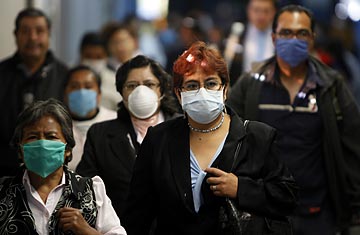
Residents of Mexico City wear masks as they exit the city's subway system.
When Moises Bonilla watched a fellow swine flu sufferer breathe her last in the isolated hospital ward, he prayed he would not follow her. The 39-year-old woman had been on the bed next to him for two days, tubes shoved into her throat, her eyes rarely flickering. Although she was unable to speak, Bonilla felt an affinity with her as he did with all his fellow patients, who egged each other on with calls to keep fighting. But she slipped away and became a reminder about how bad things could get. "It was the darkest moment I have ever had," says Bonilla, who would spend five days in the hospital. "I just tried to think about better times, about my wife and children, to give me the strength to go on."
Back in the cramped Mexico City apartment he shares with two daughters and two grandchildren, Bonilla, 46, a maintenance worker, recounts his ordeal to TIME. He has been out of hospital for two days but is still coughing and spluttering behind a blue facemask, his head aching slightly as he finishes his course of anti-viral drugs. The Mexican government has tried to protect the names of swine flu victims, fearing publicity could stigmatize them. But Bonilla is unafraid to tell his tale, hoping his words will give the world better insight into the H1N1 virus. He also wants to remind people that even if the numbers of hospitalized and dying is not as high as feared, the grief and pain for some can still be truly harrowing. "Some people think that this virus has just been made up by the government or the newspapers," he says. "But from what I have gone through I know it is a very real." (See pictures of thermal scanning used in the hunt for swine flu infection.)
A runner with a trim muscular upper body, Bonilla says he is normally in good health, and never used to be concerned about flu. "I used to think it was just something that you got in the night and that was gone the next day," he says. He hoped it would be the same when he felt a sore throat and headache develop on April 22. But the next day his temperature shot up to 102 degrees and his throat closed so tightly he could hardly breathe. "I didn't want to upset my wife and daughters, so I tried to pretend it wasn't so bad," he says. "But then the pain became so much I couldn't even stand up or sit on the sofa. I just lay on the floor and tried to breathe." (Check out a story on whether the alarm over swine flu was justified.)
Just as Bonilla was being struck down, news flashed up on the television about how the swine flu virus had been found in Mexico. His wife rushed him to a public hospital in his Iztapalapa district and he was rapidly put in isolation with five other patients. "We had no communication with the outside world — no newspapers or telephones — so we didn't know much about this swine flu or how bad it was," he recalls. "When the woman died we were scared that this could be the fate of us all." Their fears only increased when a doctor and nurse who had been attending to sufferers also developed symptoms, and themselves became patients in the ward. (See the top five swine flu don'ts)
His wife Blanca Arcos waited day and night in the hospital. Unlike her husband, she was exposed to the full media frenzy on the virus adding to her anxiety. "I couldn't get to see him at all, not even though glass. So I just had to imagine what he was going through," Arcos says, also wearing a facemask in their apartment. "I tried to tell myself he was strong. But then my other relatives would say how bad this swine flu is."
Doctors soon gave Bonilla an anti-viral drug that is known in Mexico as oseltamivir (and more popularly known as Tamiflu) making his condition rapidly improve. In some ways, the timing of sickness was lucky, he says. Once they had identified swine flu on April 23, Mexican health authorities rushed anti-virals to hospitals and found they were very effective. But many who had started suffering before had already developed severe pneumonia; and for some, it was too late to be saved. The errors in treatment in the first weeks of the outbreak do much to explain the higher death rate in Mexico than the United States. By Monday, the Mexican government had confirmed 26 deaths that were caused by the swine flu virus, compared to one north of the border.
Bonilla finally left hospital after five days — a period after which he was unlikely to be still contagious. However, he was told to remain in his apartment for another eight days, while his grandchildren stayed with relatives. No other family members have developed symptoms, reflecting a relatively low infection-rate of the virus. Bonilla is still visibly shaken by his brush with swine flu and concerned about the disease spreading around the planet. But he says that it has taught him one positive thing: to appreciate what he has. "I know that I am lucky to be here getting my health back with my wife and children around me," he says. "Now I have more incentive than ever to enjoy my life."
